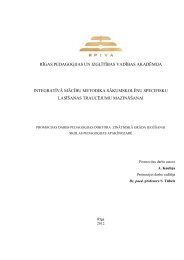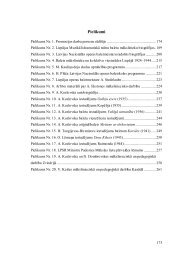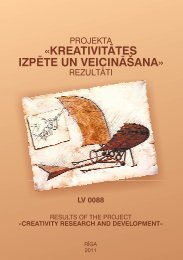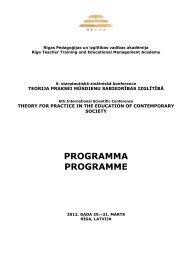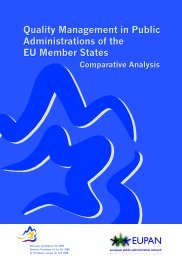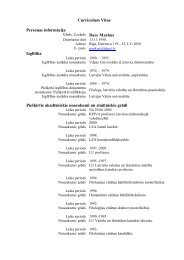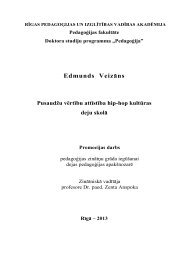saturs - rpiva
saturs - rpiva
saturs - rpiva
- No tags were found...
You also want an ePaper? Increase the reach of your titles
YUMPU automatically turns print PDFs into web optimized ePapers that Google loves.
were 5.486 EPO patent applications in the Czech Republic per a million inhabitants. The<br />
situation in the surrounding countries is not better (Hungary 5.468; Slovakia 3.411; Poland<br />
2.191). The most active countries regarding patents are Germany (194.078), Luxemburg<br />
(174.989), Sweden (134.628) and Finland (132.180). In some European regions (especially in<br />
Germany) the number of EPO patents per a million inhabitants ranges around 400 (Eurostat,<br />
2009b). The support for patent activity is also a focus of some subsidy programs, specifically<br />
the Innovation Programme (Operational Programme Enterprise and Innovations 2007–2013).<br />
The instruments for the support for patenting can also work at regional level. STP and BI<br />
often provide more affordable consulting services in this area or more affordable services to<br />
patent representatives. Moreover, the first Patent and Licence Fund (South Moravian<br />
Innovation Centre) was established at regional level. The fund provides more affordable<br />
loans for patent-related activities.<br />
The above mentioned issues are also in the focus of the National Innovation Policy.<br />
This has four basic goals which concentrate on the strengthening of research and<br />
development, the cooperation of the public and the private sectors, human resources for<br />
innovations, and making the public administration more effective in the areas of research,<br />
development and innovations. These goals also involve the increase in expenditures on R&D,<br />
the support of intellectual property protection, the establishment of the Technological Agency<br />
of the Czech Republic, and the support for technology transfer (Government of the CR:<br />
National Innovation Policy of the Czech Republic 2005–2010).<br />
CONCLUSIONS<br />
Besides high quality of education including highly specialized knowledge<br />
(practically used within relevant labour markets, starting with local markets as regards<br />
apprenticeship education), the creation and the transfer of new knowledge generated by the<br />
development of science and research, which is then commercialized in the form of<br />
innovations, are considered the main positive effects of education infrastructure from the<br />
perspective of the business segment.<br />
In the Czech Republic the knowledge infrastructure is very concentrated to the main<br />
hierarchical centres. The most significant centres are Prague (capital) and Brno (the second<br />
biggest city). The second group contains all the remaining regional capitals except Karlovy<br />
Vary, together with traditional education centre Opava.<br />
The current conditions in the tertiary education can be considered unsatisfactory, the<br />
number of students was increased but public expenditures didn‟t correspond. The ongoing<br />
reform of tertiary education is expected to resolve this problem. In the area of science and<br />
research, the most unsatisfactory phenomenon is the cooperation between the public and the<br />
private sectors. Also the technology transfer and the protection of intellectual property<br />
represent considerable drawbacks. A solution is represented by institutional changes and by<br />
financial support programs.<br />
REFERENCES<br />
1. CZSO (2008). Innovation Activities of Firms in the Czech Republic in 2004–2006.<br />
2. CZSO. Database of the Town and Municipal Statistics (MOS).<br />
3. EUROSTAT. Regional statistics. (2009a) http://epp.eurostat.ec.europa.eu (15.04.2009.)<br />
4. EUROSTAT. Statistics Database. (2009b) http://epp.eurostat.ec.europa.eu (15.04.2009.)<br />
5. Hampl, M. (2005). Geografická organizace společnosti v České republice: transformační procesy a jejich<br />
obecný kontext. Praha: DemoArt.<br />
http://www.msmt.cz/uploads/bila_kniha/schvalena_bktv/BKTV_finalni_verze.pdf (05.04.2009.)<br />
6. IFO (1989). An Empirical Assessment of Factors Shaping Regional Competitiveness in Problem Regions in<br />
Europe. Munich.<br />
7. Institute for Information on Education. Yearbooks 2006-2008. http://www.uiv.cz/rubrika/97 (25.03.2009.)<br />
242



